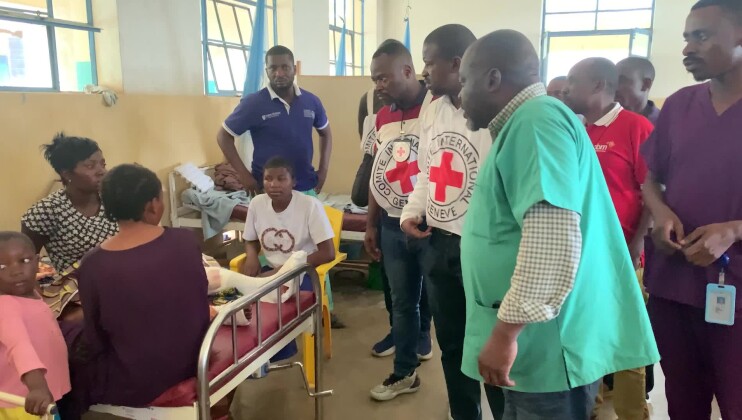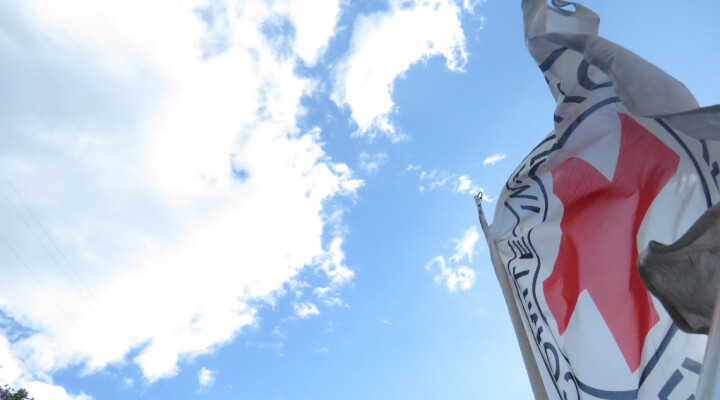Somalia: Cash lifeline for drought-hit homes
Drought has brought Somalia to the brink of famine, but a modest injection of cash can give families in rural areas a lifeline to see them into the expected rainy season. More than 55,000 homes in Somalia have already received $100 to improve their nutrition situation. The most vulnerable of them will receive up to three rounds of cash to help them get back on their feet.
Isaaq Gaas, a 54 year old farmer in Anjaraale village, 15km from Baidoa town, lost all his crops to the drought that has ravaged most of Somalia. He moved his wife and children to one of the crowded IDP camps on the outskirts of the town, so that they could get food and water from aid agencies. But Isaaq remained behind to prepare his land for the April – June rainy season, known as the Gu.
He has just received $100 in cash from the International Committee of the Red Cross (ICRC). The money is part of a program to support drought-hit families in hard to reach, conflict prone areas. With the money, Isaaq bought food for his family and, crucially, spent the rest on seedlings for the farm.
“We have no way to cope with the drought. We struggle. We just stay in our place. We have no means to cope. No way to cope with the drought.” Isaaq says.
But Isaaq is not giving up. He is determined to continue preparing for the coming rains.
“We will plant. We’ll make it a duty. We’ll persevere against the thirst. We’ll struggle. If God gives us rain, alhamdulillah! We are just waiting for rain.”
Many people in donor countries tend to view humanitarian relief in terms of goods: food, medicines, or materials for shelter. But globally, the case for cash has become increasingly compelling. At the World Humanitarian Summit in Istanbul last year, major donors and agencies pledged a Grand Bargain to increase cash programming in the delivery of humanitarian aid.
In Somalia the drought has left over half the country in need of assistance, and the ICRC has stepped up its response, supporting up to 60,000 families with cash. The $9,000,000 package complements more traditional ICRC programmes such as food and health support for drought affected communities.
Garen Ismail, 25, is the mother of six boys, and lives in the village of Jidow. Her family once had eight cows, and a farm. The drought wiped out the crops and, to survive, they sold the cattle one by one, until they were left with just one cow. When her husband became resigned to selling it too, for just $10, a text message confirming receipt of money from the ICRC programme gave them the chance to keep their last cow instead. Garen is now able to feed her six boys and intends to stay put until the next rains.
“We received the money just a day before we were to sell the last cow. We didn’t sell the cow. We’ll start afresh with it,” says Garen.
“We used the money to buy sorghum” she adds. “We bought vegetables, and maize, and ground it to make flour. And we bought water.”
Cash to victims of conflict and natural disasters in Somalia has been used by the ICRC before as an alternative approach. Since 2013, cash grants have been made to families during emergencies such as drought and floods, in cash for work programmes to dig rain water catchments or irrigation canals as well as in income support to build resilience among IDPs.
For Somalia, cash injections strengthen the local markets and, with the growth of digital payment systems, can be delivered instantly in an affordable, secure and transparent way.
And for Isaaq and Garen, the cash lifeline gives them greater choice and more control over how to meet the needs of their households during the on going crisis. More importantly, they are able to cope with the effects of the persistent drought with a greater sense of dignity.
SHOTLIST
Location: Baidoa, Somalia
Length: 6:31
Format: HD H264 mov
Camera: Mark Ng’ang’a
Sound: Somali
ICRC ref: AV635N
Date: 25th April 2017
Copyright: ICRC access all
(EXTERIOR, ISAAQ GAAS’s FARM)
00:00 - 00:13 LS ISAAQ GAAS dropping seeds to the ground and covering them with soil using his foot while moving to the left side of the screen. TILTS from SKY to Isaaq Gaas
00:13 - 00:22 CU wooden container with sorghum seeds. ISAAQ GAAS scooping seeds and dropping them to the ground. His foot can be seen covering the seeds with soil. TOP VIEW, TRACKS RIGHT TO LEFT
00:22 - 00:29 LS ISAAQ GAAS’s feet covering seeds with soil. TRACKS LEFT TO RIGHT
00:29-00:37 LS ISAAQ GAAS Dropping seeds to ground and covering them with soil. TRACKS LEFT TO RIGHT
(INTERIOR, ISAAQ GAAS’s HUT)
00:37 - 00:45 ECU ISAAQ GAAS’s hand. Flicks a gas lighter igniting a plastic paper on fire. Lowers burning paper to light a fire.
00:45-00:53 ECU ISAAQ GAAS’s face concentrating on something off screen
00:53-00:57 CU ISAAQ GAAS’s hand holding a piece of wood on a fire
00:57:-01:03 MS ISAAQ GAAS’s face concentrating on something off screen
01:03-01:12 PROFILE LS ISAAQ GAAS drinking tea in front of a fire.
(EXTERIOR, ISAAQ GAAS’s HUT)
01:12-01:15 MS ISAAQ GAAS opening the cover of his mobile phone
01:15-01:17 OVER THE SHOULDER ISAAQ GAAS pressing button of his mobile phone
01:17-01:24 OVER THE SHOULDER CU ISAAQ’s mobile phone (text reads: You have deposited $100)
SOUNDBITE Issack Abdirahman Isaack (in Somali)
01:24 - 01:51 – We have no way to cope with the drought. We struggle. We just stay in our place. We have no means to cope. No way to cope with the drought. We plant. We’ll make it a duty. We’ll persevere the thirst. We’ll struggle. If God gives us rain, alhamdulillah! We are just waiting for rain.
INTERIOR VILLAGE SHOP
1:51 – 2:00 women in shop
2:00 – 2:10 MCU counting money
2:10 – 2:18 handing over money
2:18 – 2:27 putting shopping into bag
EXTERIOR
2:27 – 2:38 tilt up scale of drought
2:38 – 2:46 MWS kids in village
2:46 – 2:51 MS kids outside hut
2:51 – 2:59 woman walking from shop to hut
2:59 – 3:04 chickens outside village huts
3:04 - 3:10 cow on its own
3:10 – 3:18 woman goes into hut, children are waiting
3:18 – 3:38 hand washing, rice bowl, tilt up to family waiting to eat
3:38 – 3:52 MS dishing out rice
3:52 – 3:56 CU dishing out rice
3:56 – 4:08 giving rice to family
4:08 – 4:27 Soundbite Garen Ismail (Somali) “We received the money just a day before we were to sell the last cow. We didn’t sell the cow. We’ll start afresh with it. We used the money to buy sorghum. We bought vegetables, and maize and ground it to make flour. And we bought water.
4:27 – 4:33 Garen washing dishes, fire in foreground
4:33 – 5:02 Garen pours water into pot, tilt up to her as she prepares food
5:02 – 5:20 Tilt down from roof of hut to cooking pots
5:20 – 5:24 Taking rice out of cans
5:24 – 5:35 Bags or rice on ground
5:35 – 6:03 Isaaq comes out of hut, walks across yard
6:03 – 6:08 Camera follows Isaaq walking with hoe
6:08 – 6:12 Isaaq walking
6:12 – 6:20 MWS Isaaq hoeing
6:20 – 6:27 WS Isaaq hoeing
6:27 – 6:31 Isaaq looking into distance
Download this footage from ICRC Video Newsroom
For further information, please contact:
Jason Straziuso, ICRC Nairobi: +254 733 622 026
Pedram Yazdi, ICRC Nairobi: + 254 700 888 131
Aurelie Lachant, ICRC Geneva: +41 79 244 64 05
To find out what the ICRC is doing to assist drought affected people in Somalia, go to
https://www.icrc.org/en/where-we-work/africa/somalia
or visit the ICRC Somalia blog: www. http://blogs.icrc.org/somalia
Follow the ICRC on facebook.com/icrc and twitter.com/icrc or twitter.com/ICRC_Africa



